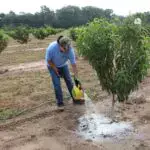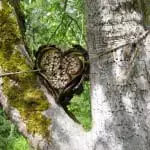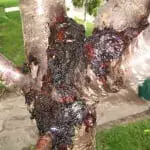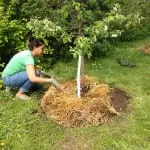Learn how beneficial nematodes can help you protect your fruit trees from plum curculio and other pests.
Beneficial Birds: Can an orchard birdhouse protect your fruit trees from pests?

orchard birdhouses: a fun way to protect your fruit trees
Fruit trees are wonderful - but not when their fruit is infested with pests like apple maggots and codling moth. There’s nothing appealing about biting into a wormy apple. And it’s frustrating to see your tree’s leaves devoured by hungry insects.
So many of us wish there was a single, easy, organic pesticide spray to help us protect our fruit trees from insect pests. Instead, organic pest prevention is a combination of different strategies. Some of them are more enjoyable to implement than others.
For instance, putting the right kind of birdhouse in your orchard (functional rather than decorative) can go a long way in limiting the number of pests that will set up shop in your fruit trees.

This is something I learned during a visit to Avalon Orchards in Innisfil, Ontario. The orchard has more than 10,000 apple trees and each row begins with a simple orchard birdhouse. These birdhouses, or nesting boxes, are designed to attracts Eastern bluebirds and tree swallows. Both are species that feast on flying insects.
“You can literally see the birds pluck the insects out of the air,” Avalon owner Gaye Trombley told me. She explained that the orchard birdhouses were a significant part of her pest prevention strategy.
Fruit Trees
That Thrive
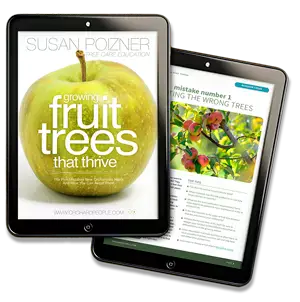
There are lots of good quality orchard birdhouses or nesting boxes available online or you can build your own nesting box using instructions from the Audubon Society. These orchard birdhouses may also be called "Eastern Bluebird nesting boxes".
testing orchard birdhouses in my community orchard
When I first learned about orchard birdhouses from Gaye, I couldn’t wait to try one myself. I managed to source a number of beautiful, reclaimed orchard nesting boxes to test in my community orchard in Ben Nobleman Park in Toronto. And I bought some extras to sell to other local orchardists.
And so the experiment began. Would the birdhouses attract residents? And would our new feathered friends help us protect our fruit trees from codling moth, apple maggots, aphids, and Japanese beetles? I asked a number of the people who installed these reclaimed birdhouses in their gardens for feedback. You can learn about their experiences below.

Creating a safe space for orchard wildlife
Chris Nolan, who lives in Willowdale, Ontario, was one of the first people to report back to me about his progress with the two reclaimed orchard birdhouses he installed. Chris has pawpaw and serviceberry trees in his yard.
“When I installed the birdhouses, I was afraid it was too late in the season to attract birds. But within two hours the birds were checking it out. They kept flying from a local hedge into the box. I soon realized they were taking material from the hedge and putting it into the box,” he said.
That’s when Chris made a mistake. He was curious to see what the birds were up to; so when he thought the birdhouse was empty, he took a screwdriver and started to open up the side of the box. Then one of the chickadees - a bird species known for eating aphids off trees and plants - flew out.

“That upset me. I think I spooked them. After that they moved to the other box and I didn’t touch that birdhouse for the rest of the season. They did have babies in that one.”
Is there room for both orchard birds and orchard humans?
Mary Nelson and her husband John Koster also bought two orchard birdhouses for their property in Ennismore, Ontario, where they are growing a variety of fruit trees including McIntosh, Empire, and Honeycrisp apples, Bartlett and Bosc pears, as well as cherry and plum trees. They felt that having birdhouses would be a key part of their pest control strategy.

Not long after they installed their birdhouses there was a lot of action. Mary sent me this wonderful (and funny!) email:
Hello Susan,
Thought I’d let you know there’s a lot of interest in the two birdhouses this week. Not sure if they’ve built in either of them, but they’re definitely “casing the joint”… John was dive-bombed yesterday and is gearing up for another onslaught as he’ll be working in the garden today. I told him to at least wear his hat so they can’t scratch him up. Do you have any advice on this? Do we carry on and the birds will get used to our presence, or will it be a constant battle? (Can’t we all just get along?)
It seems that the houses were located a bit too close to the vegetable garden and the birds felt threatened by having humans so close by. And so instead of (or perhaps, in addition to) devouring insect pests, they hunted down poor John when he was working in the garden. Still, armed with a big floppy hat, John was protected and Mary was thrilled to watch all the activity:
The birds seem to have settled down, and it seems bluebirds took up residence in the one (I’ve never seen bluebirds in real life before and we have them in our back yard this year!) while the swallows occupy the other and seem to have become more tolerant of us, she wrote in an update.
Mary and John have had no serious pest infestations so far, so they hope the birds are helping protect the trees. But they are also really enjoying watching all the action in their yard with the parents creating a nest, feeding their young, flying back and forth, and so on. They’re enjoying it so much that they have ordered four more birdhouses for next year.
But there will be one change: next year, they’ll move the birdhouses away from the vegetable garden to a more isolated area to protect the birds’ privacy - and to protect John’s head!

When it comes to species, you can’t always pick and choose
Paul Fryer lives in North York in Toronto and has nine apple trees in his large garden. Like me, he visited an organic orchard that used birdhouses as part of their Integrated Pest Management (IPM) pest prevention strategy, and he wanted to try it himself. Paul purchased two reclaimed orchard birdhouses from me and was excited to try them out.
Like Mary and Chris, his birdhouses attracted birds right away - but not necessarily the species he was hoping for:
“At this point, we are getting nothing but sparrows,” he writes. “After they had raised their first young this year, I cleaned out the bird house hoping that a different variety of bird would use the houses but the sparrows just build another nest and raised another set of young,” he says.
Sparrows do eat flying insects, but they also eat seeds, so their appetite for pests isn't as voracious as that of eastern bluebirds or tree swallows. So Paul hopes for new residents next year, that will play a bigger role in protecting his trees. He has ordered two more houses to set up in different locations in his garden. Considering that birds often come back to the same nest year after year, that might be a good idea!

Where to put your orchard birdhouse: learning from others’ mistakes
And what about my experience with our birdhouse in Ben Nobleman Park? Well, let’s put it this way. I’m a little jealous of the others! We installed our birdhouse two years ago and so far there is no sign of a tenant. Our box stands alone and lonely, with our young apple trees to the south and the cherry trees to the north.
There are no chirping babies. No dive bombing or swooping at passers by…and therefore no feasting on insect pests. What have we done wrong?
Well, all my best learning has come from my mistakes and this is no exception.
Our birdhouse in Ben Nobleman Park Community Orchard was installed right beside a pathway which local residents use to cut through the park and very close to a busy road. I didn’t really think this would be a problem at the time.
But in retrospect, I’m pretty sure that our local birds have rejected this lovely abode because it would be like living on a highway - too much human activity and not enough solitude. With all these humans walking back and forth and vehicles zooming by, would they really feel safe raising their young?
Maybe we’ll get permission to mount another birdhouse in a a different part of our orchard park one day. In the meantime, we will look wistfully at that lonely little house each time we walk by. And we can feel some solace when hearing others’ stories of success.
How to care for orchard birdhouses - and their inhabitants
Once you have your orchard birdhouse installed, how do you care for them? I asked Joe Krall, the retired tool and dye maker who has made and monitored over 500 bird boxes that have been placed in orchards and conservations areas in Ontario. Joe's Eastern bluebird birdhouses are the ones we installed in our orchard.

His advice is for us to be gentle with the birds.
"Watch them. Don’t bother them. And you can learn from the birds."
And yet, Joe still encourages the new caretakers to open the nesting boxes from time to time to check how the babies are developing: "You can open the boxes when you want to know how many eggs are there or babies. Opening the boxes once per week is enough.”
According to Joe, “Birds are under stress when you bother them. I just check how many babies are there, whether they are healthy, or if there is a dead baby or unhatched egg, I will remove it and mark it in my history. And everything is okay.”
He suggests that we clean the birdhouses twice a year by scraping out the previous nest with a scraper. Don’t use chemicals or soap.

Once you have your orchard birdhouse set up, sit back, relax, and watch the show. It's delightful to watch the birds setting up their nests and feeding their young. And knowing that those birds will be helping you protect your fruit trees from insects pests is a major bonus!

Orchard Birdhouse Q&A
Q: What birds are desirable in orchards? A: Desirable birds in orchards include species that help control insect pests. Eastern Bluebirds, for instance, are known for eating large quantities of insects, making them beneficial for orchard health. Other helpful birds include chickadees, sparrows, and swallows, which feed on harmful insects and caterpillars.
Q: What birds are not desirable in orchards and why? A: Birds that are less desirable in orchards are typically those that peck at or eat fruit, potentially causing damage to crops. This includes birds like starlings, certain types of blackbirds, and some thrushes. Their feeding habits can lead to significant fruit loss and damage.
Q: What is the point of a nesting box? A: A nesting box in orchards serves multiple purposes. It provides a safe and secure place for beneficial birds to nest and raise their young, which helps to maintain or increase their population. Additionally, these birds contribute to pest control by feeding on insects harmful to the orchard.
Q: How is an Eastern Bluebird nesting box different from a regular birdhouse or other nesting boxes? A: An Eastern Bluebird nesting box typically has specific features tailored to their needs, such as an entrance hole that's about 1.5 inches in diameter to prevent larger, undesirable birds from entering. The box is also often shallower than regular birdhouses to suit the bluebird's nesting preferences.
Q: Should you paint the birdhouse? Are bright colors okay? A: It's usually best to use natural, non-toxic paints or stains for birdhouses, as strong odors can deter birds. Bright colors are not typically recommended as they can attract predators or may not blend well with the surroundings. Natural, earthy tones are generally preferable.
Q: How do you clean an orchard birdhouse? A: Cleaning an orchard birdhouse involves removing old nesting materials, scrubbing the inside with a solution of nine parts water to one part bleach to kill any parasites or bacteria, and then rinsing and leaving the flap open for a while to allow it to dry thoroughly before rehanging. This should be done annually, ideally in late autumn or early winter after the breeding season.
Learn more about how to care for fruit trees by signing up for online fruit tree care training below! Or check out our advanced courses at Learn.OrchardPeople.com.
Fruit Trees
That Thrive


Susan Poizner
This page includes affiliate links. Orchard People may receive a small commission if you make a purchase. The funds will help support the creation of free resources including our blog, YouTube channel and podcast.
